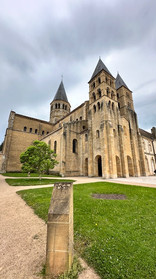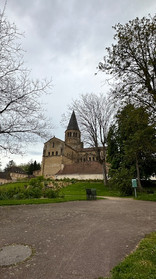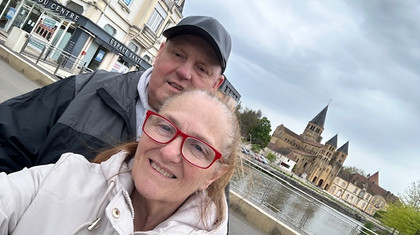Basilica Paray-Le-Monial France / Francia
- Maria Scuor
- May 23, 2024
- 5 min read
Scorri a basso per l’italiano
Paray-le-Monial is a municipality in the Saône-et-Loire department in the Burgandy-Franche-Comté region of France. It is the town where my brother Vince was born and we still have family living there. Today I’m blogging about the Basilica of Paray-Le-Monial as it is a popular landmark and one of the most visited religious sites in France.
The basilica is a Romanesque church dedicated to the Sacred Heart of Jesus because of the visions Saint Margaret Mary Alacoque saw of Jesus. Margaret Mary entered the Convent in Paray-Le-Monial in 1671 and became a nun in 1672. It was at the monastery that Margaret Mary received several revelations of the Sacred Heart, and on 27 December 1673, Margaret Mary said that Jesus had permitted her to lay her head upon his heart. In 1686, she was able to have the monastery observe the Feast of the Sacred Heart in private and two years later the chapel was built to honor the Sacred Heart which spread the observation of the feast to other convents.
Hugues de Semur, an abbot from Cluny, built the church in the 12th century on the site of the 10th-century monastery. It is a perfect replica, but much smaller scale, of what the Cluny Abbey in Cluny looked like before it was destroyed during the French Revolution. The church was completed in the 14th century, with some sections added in the 18th century or during the renovations in the 19th century. The church, as we see it today, was designated as the basilica of Paray-Le-Monial in 1875.
The exterior has massive walls with few decorations. Among the decorations are floral and geometric motifs on the portal of the left arm of the transept. The façade has a tower on each side of the entrance with roman style arches at the upper levels. If you look closely at the towers, you will see they are not the same, this is due that they were built at different times by different architects. At the back of the basilica, the chevet is traditional roman style with round chapels, the entrance door is very simple but with elegantly carved columns around the door.
The bell tower was built in the 12th century but was destroyed during the revolution. It was rebuilt in 1810 and covered with a dome. The tower consists of four parts, a square base on which the octagonal tower stands, then a storey with twin blind apertures, a third storey made up of eight bays, each having two semi-circular windows, and finally the spire which rises to 56 metres.
The interior design has three short naves, crossed by a transept with a single nave. The choir area has a semicircular apse with three chapels. There is a pointed barrel vault covering the central nave and transept with Romanesque and pre-Gothic appearance columns. The main nave is separated by the side naves with roman style arches formed by large stone columns that have carvings of foliage and biblical creatures such as eagles, griffins and lions. There is a row of high windows allowing light to flood the interior and a beautiful Pièta with its gothic niche on the left of the main alter.
It truly is a beautiful church/basilica that is so different than the churches/basilicas in Italy. Seeing it from all different angles really shows its grandeur. In June, during the Feast of the Sacred Heart of Jesus, several thousands of people come to pray in the basilica and park.
External - Esterna
Interior - Interna
Basilica Paray-Le-Monial Francia
Paray-le-Monial è un comune francese situato nel dipartimento della Saône-et-Loire nella regione della Borgogna-Franca Contea. È la città dove è nato mio fratello Vince e abbiamo ancora famiglia che vive lì. Oggi sto scrivendo un blog sulla Basilica di Paray-Le-Monial in quanto è un punto di riferimento popolare e uno dei siti religiosi più visitati in Francia.
La basilica è una chiesa romanica dedicata al Sacro Cuore di Gesù a causa delle visioni che Santa Margherita Maria Alacoque ebbe di Gesù. Margherita Maria entrò nel convento di Paray-Le-Monial nel 1671 e divenne suora nel 1672. Fu nel monastero che Margherita Maria ricevette diverse rivelazioni del Sacro Cuore, e il 27 dicembre 1673, Margherita Maria disse che Gesù le aveva permesso di posare la testa sul suo cuore. Nel 1686 riuscì a far osservare in privato al monastero la festa del Sacro Cuore e due anni dopo fu costruita la cappella in onore del Sacro Cuore, che diffuse l'osservanza della festa ad altri conventi.
Hugues de Semur, un abate di Cluny, costruì la chiesa nel XII secolo sul sito del monastero del X secolo. Si tratta di una replica perfetta, ma in scala molto più piccola, di come appariva l'Abbazia di Cluny prima di essere distrutta durante la Rivoluzione francese. La chiesa fu completata nel XIV secolo, con alcune sezioni aggiunte nel XVIII secolo o durante i lavori di ristrutturazione del XIX secolo. La chiesa, così come la vediamo oggi, fu designata come basilica di Paray-Le-Monial nel 1875.
L'esterno ha pareti massicce con poche decorazioni. Tra le decorazioni si segnalano motivi floreali e geometrici sul portale del braccio sinistro del transetto. La facciata presenta una torre su ogni lato dell'ingresso con archi in stile romano ai livelli superiori. Se guardi da vicino le torri, vedrai che non sono uguali, questo è dovuto al fatto che sono state costruite in tempi diversi da architetti diversi. Sul retro della basilica, il chevet è in stile tradizionale romano con cappelle rotonde, la porta d'ingresso è molto semplice ma con colonne elegantemente intagliate intorno alla porta.
Il campanile fu costruito nel XII secolo, ma era distrutto durante la rivoluzione. Fu ricostruita nel 1810 e coperta da una cupola. La torre è composta da quattro parti, una base quadrata su cui si erge la torre ottagonale, poi un piano con due aperture cieche, un terzo piano formato da otto campate, ciascuna con due finestre semicircolari, e infine la guglia che si eleva a 56 metri.
L'impianto interno è a tre navate corte, attraversate da un transetto a navata unica. L'area del coro presenta un'abside semicircolare con tre cappelle. C'è una volta a botte a sesto acuto che copre la navata centrale e il transetto con colonne di aspetto romanico e pregotico. La navata principale è separata dalle navate laterali con archi in stile romano formati da grandi colonne in pietra che presentano intagli di fogliame e creature bibliche come aquile, grifoni e leoni. C'è una fila di alte finestre che permettono alla luce di inondare l'interno.
E' davvero una bella chiesa/basilica che è così diversa dalle chiese/basiliche in Italia. Vederlo da tutte le diverse angolazioni mostra davvero la sua grandezza. A giugno, durante la festa del Sacro Cuore di Gesù, diverse migliaia di persone vengono a pregare nella basilica e nel parco.











































Comentários